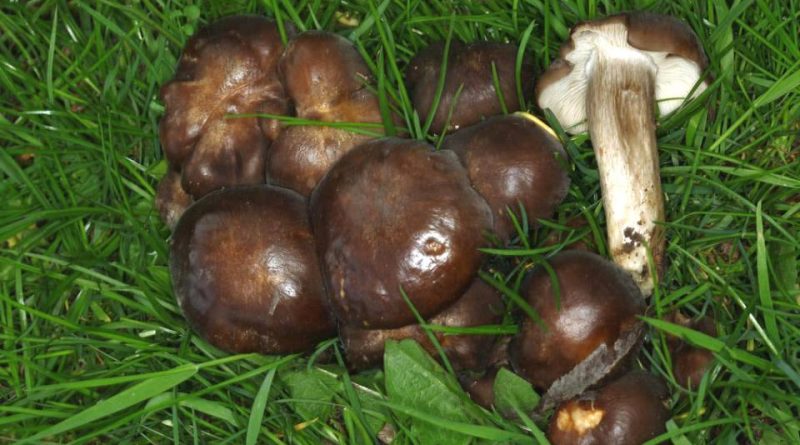Lyophyllum loricatum
Lyophyllum loricatum
Lyophyllum loricatum (Lyophyllum loricatum (Fr.) Kühner ex Kalamees, 1994) is a basidiomycete mushroom belonging to the Tricholomataceae family.
Systematic –
From the systematic point of view it belongs to the Domain Eukaryota, Kingdom Fungi, Basidiomycota Division, Class Basidiomycetes, Order Agaricales, Family Tricholomataceae and then to the Genus Lyophyllum and then to the Species L.loricatum.They are the terms: Agaricus loricatus Fr., Gyrophila cartilaginea var . loricata (Fr.) Quél., Lyophyllum decastes var. loricatum (Fr.) Kühner, Lyophyllum loricatum (Fr.) Kühner ex Kalamees, Tricholoma loricatum (Fr.) Gillet and Lyophyllum loricatum f. loricatum (Fr.) Kühner.
Etymology –
The term Lyophyllum comes from the Greek λύω lýo dissolve, separate, break and from φύλλον phýllon leaf, lamella: for the lamella without conjunctions, without anastomosis. The specific epithet loricatum comes from armored, from loríca armor.
Geographic Distribution and Habitat –
Lyophyllum loricatum is a fungus found between grass and mixed woods, large tufts but also gregarious specimens. Fruits in the period from summer to autumn.
Recognition –
Lyophyllum loricatum is recognized for having a hat with a diameter of 4-12 cm, initially globose, long convex, then with the plan-convex growth, in the central part there is a low umbo, especially in young specimens, which with the growth it also becomes depressed, hygrophanous, of a dark brown to quite homogeneous color, even with small areas bleached in light ocher tones. The cuticle is glabrous, unctuous, slightly fibrillose, non-pruinose, elastic-cartilaginous. The margin is whole, involute, with sinuous, wavy pattern. The meat of the hat has a hard and cartilaginous consistency (it is appreciated to the touch and to the break with a scratched). The lamellae are white, then yellow, more or less dense, attached to the stem. The stem is cylindrical, tenacious, central, streaked, of gray-ocher color, not straight, sinuous to twisted, influenced by the growth conditions, often very buried and bushy. The meat is rather tough, white, elastic, with a sub-floury herbaceous smell and sweet taste. Under the microscope, globose spores are seen, white in mass.
Cultivation –
Lyophyllum loricatum is not a cultivated fungus.
Uses and Traditions –
It is a fungus, relatively common, considered to be good to excellent edibility. Regarding the possible similarities to other species we remember:
– Lyophyllum calabrum Lavorato & Contu, which has a hat with pale brownish pink colors, quite original and distinctive compared to other European species. Localized and known in Calabria;
– Lyophyllum decastes (Fr.) Singer, which is characterized by its gray-brown, ash-gray hat, bushy growth, posture and consistency of brittle meat – Lyophyllum littorale (Ballero & Contu) Contu, which is very similar to Lepista panaeola , for the hat with an abundant pruinosità, decorated with blackish guttule, has subglobose spores and characteristic habitat in maritime pine groves on sandy ground;
– Lyophyllum conglobatum (Vittad.) Bon = Lyophyllum fumosum (Pers.) P.D. Orton, which has a characteristic growth, with bushy specimens that develop from a basal fleshy mass, very buried. It has dark gray colors.
Preparation Mode –
Lyophyllum loricatum can be eaten after cooking and not too much. However, any individual incompatibilities are not excluded.
Guido Bissanti
Sources
– Wikipedia, the free encyclopedia.- Cetto B., 2008. The mushrooms from life, Saturnia, Trento.- Pignatti S., 1982. Flora of Italy, Edagricole, Bologna.- Conti F., Abbate G., Alessandrini A., Blasi C. (edited by), 2005. An annotated checklist of the Italian vascular flora, Palombi Editore.
Warning: Pharmaceutical applications and alimurgical uses are indicated for informational purposes only and do not in any way represent a medical prescription; there is therefore no liability for their use for curative, aesthetic or food purposes.


